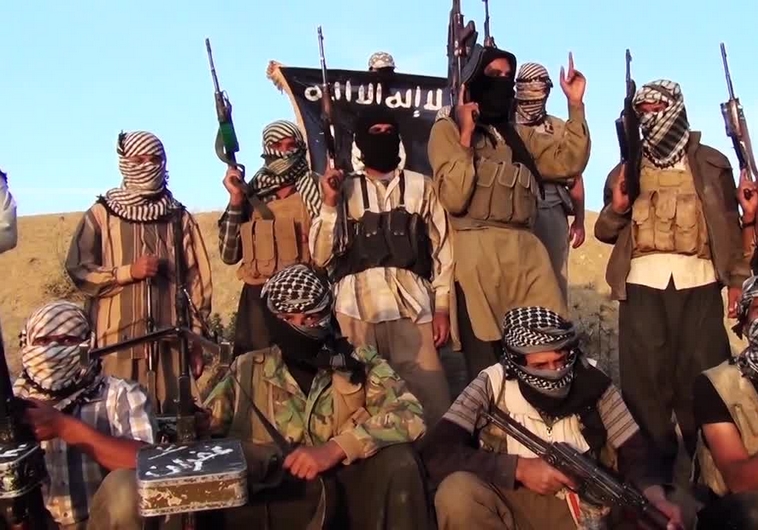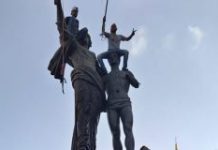Behind the lines: Islamic State comes to Damascus
By JONATHAN SPYER/J.Post/04/18/2015
The latest reports suggest that Islamic State fighters have largely withdrawn from the Palestinian refugee camp of Yarmuk, on the outskirts of Damascus.
The jihadis have returned to the district of Hajar al-Aswad, from where they launched their assault into the camp on April 1; the strongest element in the camp now is Jabhat al-Nusra, the Syrian franchise of al-Qaida.
Islamic State does not seem to have suffered a major defeat in Yarmuk.
Rather, their intention was to strike a blow against the Hamas-affiliated Aknaf Beit al-Maqdis – and this appears to have been achieved.
But the broader significance of the week’s events far transcend the boundaries of the Yarmuk refugee camp. Most important, the Yarmuk fighting marks the definitive arrival of Islamic State into the arena of the Damascus battlefield.
This battlefield is itself heating up amid growing difficulties for the Assad regime; Iranian, Hezbollah and regime forces have suffered setbacks in recent days to the combined forces of Nusra and the Southern Front of the Free Syrian Army. The rebels are seeking to establish a secure line south of Damascus from where they can launch strikes directly into the city.
Islamic State has lost some of the areas of Iraq it conquered last summer.
The general direction of the fighting there points toward a slow retreat by the jihadis (though not exclusively – the town of Ramadi close to Baghdad is now threatened by the movement).
But while locked in a largely defensive posture in Iraq (and while continuing to lose ground in northern Syria to Kurdish forces backed by US air power), Islamic State is proving it is able to push forward in areas where it needn’t concern itself with attacks from Western planes.
The regime-controlled areas of the southwest are in this regard a natural choice for Islamic State. Yarmuk is the first evidence of this commitment.
The Yarmuk events also point to the ambiguous role being played by Jabhat al-Nusra regarding its relationship with Islamic State. Nusra has a longstanding rivalry with Aknaf Beit al-Maqdis in Yarmuk, relating to issues of turf and control as much as ideology. The Islamic State attack on Yarmuk began from areas close to those controlled by Nusra; other Palestinian factions accused Nusra of colluding with Islamic State.
Certainly, Nusra did not join in the fighting against Islamic State. Moreover, the movement’s withdrawal from Yarmuk leaves Nusra the strongest faction in the area. PLO envoy Anwar Abd-al Hadi told Reuters that “they [Islamic State and Nusra] are one. They are changing positions.”
Nusra, for its part, denies claims of collusion and says it remains committed to the defense of the people of the Palestinian refugee camps from “extremists.” Yet the facts of the situation suggest at least an agnostic attitude toward Islamic State from the powerful Nusra, and perhaps something more.
So what lies ahead? It is not clear whether the fighting in the camp has completely ceased. But even if it has, Islamic State has not been defeated, having merely withdrawn back to its stronghold in the Hajjar Aswad neighborhood adjoining the camp.
The emergence of Islamic State close to the Syrian capital may have become suddenly apparent with the attack on April 1. But in a way now familiar from the group’s practice, first in Raqqa and then in its assault on Iraq last June, the movement is adept at quietly building its presence through clandestine networks of supporters, before suddenly and abruptly announcing its arrival.
If this is taking place in the Yarmuk area, it may be assumed it is happening elsewhere, too – in a way that is likely to become apparent in the period ahead.
In parallel, the regime is getting weaker in southern Syria, and the relationship between the potent forces of Nusra and the other Western-backed rebel formations is declining.
Yarmuk is not the only evidence of this. Rebels affiliated with the Western-backed Southern Front this week released a statement condemning Nusra’s ideology and rejecting cooperation with it.
Bashar al-Zoubi, one of the leaders of the Southern Front, told Reuters that “neither Nusra nor anything else with this ideology represents us… We can’t go from the rule of [Syrian President Bashar] Assad to [al-Qaida chief Ayman al-] Zawahiri and Nusra.”
Tensions are growing between Nusra and the Southern Front elsewhere in the south. On April 1, the rebels took the Nasib border crossing from regime forces; it was the last regime-controlled crossing between Jordan and Syria. Nusra and Western-backed rebel elements have been competing over credit for the capture of this area.
This raises the possibility of further tactical cooperation between Islamic State and Nusra in the south, of the type seen in the Qalamoun area, and also apparently in Yarmuk.
And finally, last Saturday fighters declaring loyalty to Islamic State launched an unsuccessful assault on the Khalkhalah military airport in Sweida Province, south of Damascus. This is a further indication of the emergent Islamic State presence on the southern battlefield.
What all this means is that the period in which Islamic State could be assumed to be at a safe distance from the part of Syria closest to Israel appears to be drawing to a close.
And as the regime weakens, the prospect is opening up for a three-way fight between the Assad regime/Iran/Hezbollah, the jihadists of Nusra and Islamic State, and the weaker Western-backed rebels.
The strange events in the blighted Yarmuk refugee camp this week may well represent the opening salvo in a new phase of the Syrian war.


















